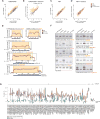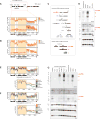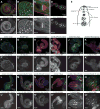The Conserved RNA Exonuclease Rexo5 Is Required for 3' End Maturation of 28S rRNA, 5S rRNA, and snoRNAs
- PMID: 29045842
- PMCID: PMC5662206
- DOI: 10.1016/j.celrep.2017.09.067
The Conserved RNA Exonuclease Rexo5 Is Required for 3' End Maturation of 28S rRNA, 5S rRNA, and snoRNAs
Abstract
Non-coding RNA biogenesis in higher eukaryotes has not been fully characterized. Here, we studied the Drosophila melanogaster Rexo5 (CG8368) protein, a metazoan-specific member of the DEDDh 3'-5' single-stranded RNA exonucleases, by genetic, biochemical, and RNA-sequencing approaches. Rexo5 is required for small nucleolar RNA (snoRNA) and rRNA biogenesis and is essential in D. melanogaster. Loss-of-function mutants accumulate improperly 3' end-trimmed 28S rRNA, 5S rRNA, and snoRNA precursors in vivo. Rexo5 is ubiquitously expressed at low levels in somatic metazoan cells but extremely elevated in male and female germ cells. Loss of Rexo5 leads to increased nucleolar size, genomic instability, defective ribosome subunit export, and larval death. Loss of germline expression compromises gonadal growth and meiotic entry during germline development.
Keywords: RNA exonuclease; U8 snoRNA; rRNA 3′ end maturation; rRNA biogenesis; rRNA processing; snoRNA 3′ end maturation; snoRNA biogenesis; snoRNA processing.
Copyright © 2017 The Authors. Published by Elsevier Inc. All rights reserved.
Figures







References
-
- Anderson MG, Perkins GL, Chittick P, Shrigley RJ, Johnson WA. drifter, a Drosophila POU-domain transcription factor, is required for correct differentiation and migration of tracheal cells and midline glia. Genes Dev. 1995;9:123–137. - PubMed
MeSH terms
Substances
Grants and funding
LinkOut - more resources
Full Text Sources
Other Literature Sources
Molecular Biology Databases

